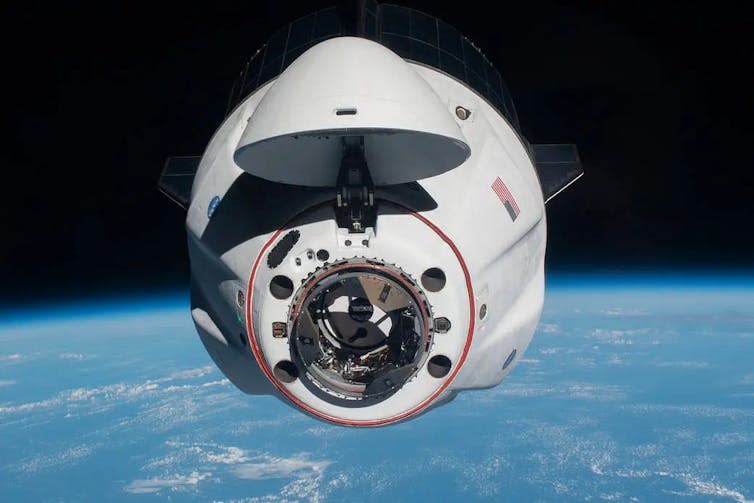Humans have long dreamed of setting foot on the Moon and other planetary bodies such as Mars. Since the 1960s, space travelers have been fitted with suits to protect them from the vacuum of space and ventured into the unknown.
However, the Polaris Dawn mission, which is meant to be the first spacewalk organized by a private company, has been delayed. This is due to difficulties in the design and development of a suitable space suit.
Moonsuits are one of the key features of NASA’s yet-to-be-delivered Artemis lunar program. A report released in November 2023 said the contractor making the suits had to revisit aspects of the design provided by NASA, which could introduce delays.
But the first spacewalk, made by Soviet cosmonaut Alexei Leonov, took place in 1965. Later, 12 NASA astronauts would walk on the surface of the moon, between 1969 and 1972, using technology that would leave today’s smartphones in league So it is not unreasonable to ask why it is still difficult to design and build a space suit to do the same thing.
A lot has changed since the Apollo missions set foot on the Moon. The geopolitics driving space travel have changed, and spacesuits are no longer considered a form of protection. Instead, they are a vital way to improve astronaut productivity. This means rethinking not only the devices themselves, but the technology that supports them.

Today’s spacesuits feature a range of powerful telecommunications technologies to connect astronauts to space stations and ground control alongside multi-sensor cameras, temperature readers and proximity sensors.
Situational awareness – understanding key aspects of the environment, such as an astronaut’s health, is critical to operator safety – a fundamental principle of modern spacesuit design. A suit’s ability to track heart rate and other vital signs is important in a vacuum, where oxygen levels need to be constantly monitored.
Expectations regarding the risks astronauts take have changed for the better. And because of the level of investment it takes to produce a space suit it is necessary that it can be used for future tasks which could include a lunar settlement in the coming years.
It’s a trade-off that engineers must make when incorporating wearable technology such as those previously mentioned. Will better situational awareness result in a spacesuit too heavy to move into effectively?
When Elon Musk first hinted at challenges with the extravehicular space suit for Polaris Dawn in a presentation to SpaceX employees in JanuaryHe didn’t discuss difficulties with connected technology, but redesigning “the suit so you can move around it”.
Situational awareness
However, when you’re talking about mobility in a spacesuit, you need to think about the tasks you want that mobility to support.
Before the advent of the modern space suit, Apollo astronauts struggled to complete missions. When drilling into the surface of the Moon with a hand drill to collect samples, astronauts found it difficult to provide enough downward force to counteract the Moon’s weak gravity. It wasn’t until the invention of the zero-gravity drill, decades later, that this problem was addressed.
The current exploration of air exoskeletons, which provide the necessary support for locomotion in low gravity, could be part of a solution. However, newer spacesuits may need to interface with hardware, such as robotic drills that exist outside the suit. This will also require greater mobility in space accessories.
Working with robots
Offloading tasks previously performed by humans to robots will be part of the future of space exploration. It is a primary way in which engineers will be able to improve the mobility of astronauts in spacesuits.
For example, when an astronaut goes on a spacewalk to inspect the condition of a part of a space station and make any repairs, they are supported by a robotic arm that ensures they don’t float into space. Although jointed, this arm is rigid and can limit an astronaut’s movement.
An approach currently being explored to extend this range of motion is a climbing robot, attached to the astronaut and the space station, that can be controlled by a human through the space suit. This would allow the astronaut to move around the space station faster and with a greater range of motion than before, allowing them to reach and repair hard-to-reach areas such as corners.
While it is hoped that robots will eventually be able to assess and repair any damage to the space station themselves, due to potential disruption to normal operations, humans must be prepared to step in. , or human-made, such as hacking carried out by a hostile group or state.
When it comes to the kinds of activities we want to accomplish in the future, human-robot collaboration will be key. Building a base on the Moon, as the US and China plan to do, will involve construction and drilling, which humans will not be able to do on their own. Modern spacesuits must provide an interface to work with this new technology, and we can expect the suits to evolve in line with robotics.
The relationship between humans and robots is changing. It will go beyond spacewalks and previous uses of robots as limited tools, to a situation where they are collaborative partners in space. Objectives ten or 20 years from now, such as building lunar settlements, exploring mineral deposits on the Moon and efficiently repairing space station modules can only be achieved using robotics.
Modern spacesuits will be the cornerstone of this collaborative relationship, and will be the interface where astronauts and robots can work together to achieve common goals. So when we leave our footprints on other worlds again, we will no longer be alone.
This article from The Conversation is republished under a Creative Commons license. Read the original article.


Yang Gao has received funding from UKRI, UKSA and ESA to carry out space-related research.